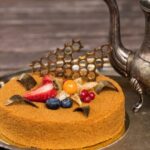Freezing cake before decorating is a secret weapon that every baker should have in their arsenal. Not only does it allow for better time management and flexibility, but it also significantly enhances the taste and texture of the final product. By undergoing the freezing process, cakes are able to retain moisture and flavor while maintaining their structural integrity, resulting in a supremely moist and delicious dessert.
Proper cake freezing techniques are essential to achieve the desired results. This includes using proper packaging materials, such as airtight containers or double wrap with plastic wrap and foil, to prevent freezer burn and maintain freshness. Additionally, understanding how long you can freeze the cake before decorating is crucial in order to avoid any negative effects on its quality.
In this comprehensive guide, we will delve into the world of freezing cakes before decorating. We will explore how long different types of cakes can be safely frozen without compromising taste or texture.
Furthermore, we will discuss various factors that need to be considered when deciding how long to freeze your cake, such as ingredients used and specific dietary restrictions. Whether you’re a professional baker or someone who simply enjoys baking at home, this guide will equip you with all the necessary knowledge to achieve flawless frozen cakes every time.
Understanding the Proper Cake Freezing Techniques
Properly freezing a cake before decorating is crucial to maintain its freshness and texture. By following the correct techniques, you can preserve the taste and quality of your cake, allowing for easier decorating and a more professional finish. Here are some key steps to ensure you freeze your cake correctly:
- Allow the cake to cool completely: Before freezing your cake, it is essential that it has cooled down completely. If you attempt to freeze a warm or even slightly warm cake, it can result in condensation forming inside the packaging, causing the cake to become soggy and lose its shape.
- Wrap the cake tightly: To prevent freezer burn and protect the cake from absorbing any odors from other foods in the freezer, it is important to wrap it tightly. Begin by wrapping each layer individually in plastic wrap, ensuring there are no openings or gaps where air can enter. Then, place each wrapped layer into a zip-top freezer bag or wrap them in aluminum foil.
- Label and date the packaging: It is crucial to label each package with the date of freezing and any additional relevant information such as flavor or type of frosting used. This will help you keep track of how long the cake has been frozen for and make it easier when deciding which cakes to use first.
- Place in a sturdy container: After wrapping and labeling your cakes, store them in a sturdy container that will protect them from getting crushed or damaged while they are freezing. Make sure there is enough space between each piece of cake to prevent sticking together.
| Step | Description |
|---|---|
| Allow the Cake to Cool Completely | Ensure that the cake has cooled down entirely before starting the freezing process. |
| Wrap the Cake Tightly | Use plastic wrap and freezer bags or aluminum foil to tightly seal each layer of the cake individually. |
| Label and Date the Packaging | Label each package with the freezing date and any relevant information for easy identification later on. |
| Place in a Sturdy Container | Store the wrapped cakes in a sturdy container that will protect them from getting damaged or crushed during freezing. |
By following these proper cake freezing techniques, you can ensure that your cakes remain fresh and delicious, ready to be decorated whenever you need them. Taking the time to freeze your cakes correctly will result in better decorating results and happy customers or guests who enjoy your beautifully decorated creations.
How Long Can You Freeze Cake Before Decorating
When it comes to freezing cake before decorating, one of the most frequently asked questions is how long can you freeze a cake before it starts to lose its quality and taste. This comprehensive guide will provide you with all the information you need to know about how long you can safely freeze your cake before decorating.
The length of time you can freeze a cake depends on several factors such as the type of cake, the ingredients used, and the method of freezing. In general, most cakes can be frozen for up to three months without significantly impacting their taste and texture.
However, some cakes may only have a freezer life of one month or less. It is important to note that while your cake may still be edible after this time period, its quality may start to deteriorate.
To help you better understand how long you can freeze different types of cakes before decorating, here is a breakdown:
| Cake Type | Freezing Time |
|---|---|
| Butter Cake | Up to 3 months |
| Sponge Cake | Up to 1 month |
| Chocolate Cake | Up to 3 months |
| Fruit Cake | Up to 6 months |
It’s essential not to exceed these recommended freezing times as prolonged freezing can result in changes in flavor and texture. Always make sure your cake is properly wrapped and stored in an airtight container or wrapped tightly in plastic wrap or foil before placing it in the freezer. This will prevent moisture loss and maintain the quality of your cake during freezing.
The Effects of Freezing on Different Cake Types
Freezing cakes has become a common practice among bakers and cake decorators, as it offers several benefits such as convenience, extended freshness, and ease of decorating. However, it is important to understand how different cake types react to the freezing process. The effects of freezing can vary depending on the composition and texture of the cake.
Butter-based cakes, such as pound cakes or butter cakes, tend to freeze exceptionally well. The high-fat content in these cakes helps to retain moisture and prevent drying out during freezing. Sponge cakes or chiffon cakes, on the other hand, may experience slight changes in texture after being frozen. They may become slightly denser but still remain delicious.
When it comes to frosted or filled cakes, freezing can have an impact on the consistency of the frosting or filling. For example, cream cheese frosting may become slightly grainy after freezing and thawing. It is essential to consider this when choosing which type of cake to freeze if you plan on using certain frostings or fillings that are not freezer-friendly.
It is also worth noting that delicate decorations or intricate designs on cakes may not hold up well during freezing and thawing. Some decorative elements like edible flowers, fresh fruit, or whipped cream may lose their appearance or integrity when frozen. Therefore, it is crucial to assess the suitability of your chosen cake type for freezing based on your desired decorations and design aesthetics.
Factors to Consider When Deciding How Long to Freeze Your Cake
When it comes to freezing a cake before decorating, one of the most important factors to consider is how long you should freeze the cake for. The length of time your cake can safely be in the freezer depends on several factors, including the type of cake and the storage conditions.
Firstly, it is crucial to take into account the type of cake you are planning to freeze. Generally, most types of cakes can be kept frozen for up to three months without compromising their quality and taste. However, certain types of cakes may have a shorter or longer freezing lifespan.
For example, butter-based cakes tend to freeze better than chiffon or sponge cakes due to their higher fat content which helps maintain moisture during the freezing process. It is essential to research specific guidelines for the type of cake you are working with in order to determine how long it can be successfully stored in the freezer.
In addition to considering the type of cake, you should also take into account the storage conditions. Proper packaging is key when freezing a cake. To prevent freezer burn and maintain freshness, wrap your cake tightly in plastic wrap or aluminum foil before placing it in an airtight container or freezer bag.
The container should be labeled with the date of freezing to keep track of its age. Moreover, storing your frozen cake at a consistent temperature below 0°F (-18°C) will help preserve its quality for a longer period.
It is important to note that while most cakes can safely be frozen for several months, they are best enjoyed within the first 1-2 months after freezing as flavors and textures may start degrading over time. Therefore, when deciding how long to freeze your cake before decorating, it is recommended to consider factors such as the type of cake and storage conditions while aiming for a timeframe within this optimal enjoyment window.
Tips for Maintaining Cake Quality while Freezing
Maintaining cake quality while freezing is crucial to ensure that the cake remains delicious and fresh when it is eventually thawed and decorated. Here are some tips to help you maintain the best possible quality of your cake while freezing:
Properly Wrap or Package the Cake
To prevent the cake from drying out or absorbing odors from the freezer, it is essential to wrap or package it correctly. Start by allowing the cake to cool completely after baking. Then, tightly wrap it in several layers of plastic wrap, making sure that there are no exposed areas. For additional protection, place the wrapped cake in airtight freezer-safe containers or resealable plastic bags.
Label and Date Your Cake
Freezing cake can sometimes make it difficult to remember important details such as the flavor or date it was made. To avoid any confusion, label each wrapped cake with its flavor and date before placing it in the freezer. This will make it easier for you to keep track of which cakes have been frozen for longer periods of time.
Choose a Suitable Freezer Location
The location where you freeze your cake can also impact its quality. Avoid storing cakes in locations within the freezer where they might be exposed to excessive temperature fluctuations, such as near the door or vents. Instead, choose a section within your freezer that maintains a consistent temperature.
Avoid Freezing Decorations
If your cake includes delicate decorations such as fondant or intricate piping work, it is better to add these decorations after thawing rather than freezing them along with the cake. The freezing process can cause decorative elements to become soggy or lose their shape, leading to a less visually appealing final result.
By following these tips, you can ensure that your cake maintains its moistness and flavor throughout the freezing process, setting yourself up for success when it comes time to decorate.
Thawing and Defrosting Cake
Thawing and defrosting a frozen cake properly is crucial to maintaining its quality and ensuring that it is ready for decorating. Improper thawing techniques can result in a cake that is soggy, dry, or unevenly thawed. To help you achieve the best results, here are some best practices for thawing and defrosting your frozen cake.
Thawing Time
The amount of time it takes to thaw a frozen cake depends on its size and the temperature at which it is thawed. As a general rule, most cakes will take about 2-3 hours to completely thaw at room temperature.
However, larger cakes may take longer, so it’s important to plan accordingly. If you’re short on time, you can speed up the thawing process by placing the wrapped cake in the refrigerator for a few hours before transferring it to room temperature.
Keep It Covered
When thawing your cake, it’s essential to keep it covered to prevent any moisture loss or absorption of odors from other foods in your fridge or freezer. Wrapping your cake tightly in plastic wrap or storing it in an airtight container will help retain moisture and protect its flavor.
Avoid Condensation
One key challenge when thawing a cake is preventing condensation from forming on the surface as it reaches room temperature. This condensation can make the cake damp and affect how well frosting adheres to its surface. To minimize condensation, allow the wrapped or covered cake to come to room temperature before unwrapping or removing the lid.
Test for Thawness
To ensure that your cake has fully defrosted before decorating, insert a toothpick into the center of the cake once you believe it may be thawed. If the toothpick comes out clean or with only a few crumbs, the cake is ready for decorating. However, if there is still moisture or resistance when inserting the toothpick, allow the cake to thaw for a bit longer.
By following these best practices for thawing and defrosting your frozen cake, you can ensure that it maintains its texture, flavor, and moisture content. Once completely thawed, your cake will be ready for decorating and will provide a perfect canvas for your creativity to flourish.
Decorating Frozen Cake
When it comes to decorating a frozen cake, there are a few techniques and recommendations that can help you achieve the best results. Decorating a frozen cake can be a bit different than working with a freshly baked cake, but with the right approach, you can still create beautiful designs and decorations. Here are some tips to consider when decorating your frozen cake:
- Allow the cake to thaw properly: Before you start decorating your frozen cake, it’s important to make sure that it has completely thawed. This is crucial because if the cake is still partially frozen, condensation can form on the surface and cause your decorations to become soggy or runny.
To thaw your cake properly, transfer it from the freezer to the refrigerator and allow it to defrost overnight. Once it is fully defrosted, let it sit at room temperature for about an hour before decorating. - Use a crumb coat: A crumb coat is a thin layer of frosting that is applied to the entire cake before adding the final layer of frosting or decorations. This helps to seal in any crumbs and create a smooth surface for your decorations. When working with a frozen cake, using a crumb coat becomes even more essential because it helps prevent moisture from seeping into the cake while you decorate.
- Work quickly: When decorating a frozen cake, it’s important to work quickly because as the cake thaws, moisture can accumulate on its surface. This moisture can make it difficult for your decorations to adhere properly or cause them to melt or smudge. To ensure successful decoration, have all your tools and materials ready before you start working with the frozen cake.
- Consider using buttercream instead of fondant: While fondant is often used for elaborate decorations on cakes, when working with a frozen cake, buttercream may be easier to handle and more forgiving. Buttercream frosting tends to hold up better in colder temperatures and allows for more flexibility in terms of design and texture. It can also help prevent any changes in consistency that may occur when working with fondant on a frozen cake.
By following these techniques and recommendations, you can confidently decorate a frozen cake and create stunning designs. Just remember to allow the cake to thaw properly, use a crumb coat, work quickly, and consider using buttercream instead of fondant for a smoother decorating experience. With practice and patience, you’ll be able to master the art of decorating frozen cakes and impress your guests with beautiful creations.
FAQs about Freezing Cake before Decorating
When it comes to freezing cake before decorating, there may be some common questions that arise. In this section, we will address some frequently asked questions to help you gain a better understanding of the process.
1. Can I freeze any type of cake?
While most types of cakes can be successfully frozen, it’s important to note that certain cakes freeze better than others. Generally, moist and dense cakes such as chocolate, carrot, and pound cakes freeze well due to their higher fat and moisture content. However, delicate or light-textured cakes like sponge or angel food cakes may not retain their texture after being frozen.
2. How long can I freeze a cake before decorating?
The length of time you can freeze a cake before decorating depends on several factors such as the type of cake, how it is wrapped and stored, and your own personal preferences. In general, frosted or filled cakes can be frozen for up to 2-3 months without compromising their quality. However, if your cake is unfrosted or only lightly frosted, it can be stored in the freezer for up to 6 months.
3. What is the best way to wrap and store a cake for freezing?
To ensure optimal freshness and prevent freezer burn, proper wrapping and storage are crucial when freezing a cake. First, allow the cake to cool completely before wrapping it tightly with plastic wrap or aluminum foil. For added protection, place the wrapped cake in an airtight container or freezer bag. Be sure to label the container with the date of freezing.
4. Do I need to thaw my frozen cake before decorating?
Yes, it is necessary to thaw your frozen cake before decorating it. Thawing should be done slowly in the refrigerator rather than at room temperature to prevent the cake from drying out. Depending on the size of the cake, it may take anywhere from a few hours to overnight to thaw completely.
5. Can I refreeze a cake that has been previously frozen?
It is generally not recommended to refreeze a cake that has already been frozen and thawed. The quality and texture of the cake may be compromised, resulting in a less desirable outcome. It’s best to freeze only the amount of cake you need at a time to avoid the need for refreezing.
By understanding these frequently asked questions about freezing cake before decorating, you can ensure that your cakes maintain their freshness and quality for when you’re ready to create stunning decorations.
Conclusion
In conclusion, mastering the art of freezing cake before decorating can greatly contribute to your success in creating beautifully designed and delicious cakes. By understanding the proper cake freezing techniques and taking into account the effects of freezing on different cake types, you can confidently decide how long to freeze your cake. Factors such as the type of cake, ingredients used, and personal preferences should be considered when making this decision.
To maintain the quality of your frozen cake, it is important to follow a few key tips. Wrapping the cake properly in plastic wrap or aluminum foil will help prevent freezer burn and maintain its moisture. It is also recommended to place the wrapped cake inside an airtight container or freezer bag for added protection. Additionally, storing the frozen cake on a flat surface will help ensure that its shape remains intact.
Thawing and defrosting your frozen cake properly is crucial before decorating. The best practice is to allow the cake to thaw slowly in the refrigerator overnight or at room temperature for several hours. This gradual thawing process helps retain moisture and prevents any potential damage to the texture.
When it comes time to decorate your thawed cake, it is important to use techniques that work well with a frozen base. Using buttercream frosting instead of delicate creams or whipped toppings will provide better stability for your decorations. Additionally, allowing the icing to set for a short period of time before adding intricate designs will help prevent smudging or melting.
By following these guidelines and taking advantage of our comprehensive guide on how long you can freeze a cake before decorating, you can confidently create stunning cakes with ease. With practice and experimentation, you will develop your own techniques and recommendations that work best for you. So go ahead, freeze those cakes, unlock your creativity, and enjoy the satisfaction of baking masterpieces.
Frequently Asked Questions
How long should you freeze a cake before frosting it?
The ideal amount of time to freeze a cake before frosting it may vary slightly depending on the recipe and personal preference. However, a general recommendation is to freeze the cake for at least 30 minutes to 1 hour.
Freezing the cake helps firm it up, making it easier to handle and frost without causing any crumbs or damage to the cake layers. It also allows the flavors to develop further as the cold temperature helps in setting and enhancing the taste of the cake.
Is it OK to freeze cake before decorating?
Yes, it is absolutely okay to freeze a cake before decorating it. In fact, freezing cakes can be quite beneficial for both convenience and taste purposes. Freezing the cake allows you to make it in advance, saving you time and stress when you are ready to decorate.
It also helps in locking in moisture, preserving freshness, and preventing staleness. Additionally, freezing can make it easier to handle delicate or layered cakes during the decoration process, minimizing any risk of crumbling or breakage.
Can you bake a cake freeze and decorate later?
Absolutely! Baking a cake, freezing it, and then decorating later is a common practice among bakers. This approach offers flexibility and convenience when you have limited time or need to prepare ahead for an event or celebration.
To do this successfully, ensure that your baked cake has completely cooled down before wrapping it tightly with plastic wrap or aluminum foil before placing it in the freezer. When you are ready to decorate later, allow sufficient time for thawing at room temperature while still wrapped – typically a few hours or overnight – before proceeding with frosting and decoration techniques of your choice.

Welcome to my blog about home and family. This blog is a place where I will share my thoughts, ideas, and experiences related to these important topics. I am a stay-at-home mom with two young children. I hope you enjoy reading it! and may find some helpful tips and ideas that will make your home and family life even better!





